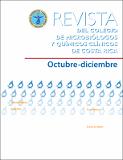| dc.contributor.author | BARQUERO-CALVO, ELIAS | |
| dc.date.accessioned | 2020-08-12T20:14:00Z | |
| dc.date.available | 2020-08-12T20:14:00Z | |
| dc.date.issued | 2015-10 | |
| dc.identifier.issn | 2215-3713 | |
| dc.identifier.uri | http://hdl.handle.net/11056/17879 | |
| dc.description.abstract | Las enfermedades infecciosas pueden clasificarse en dos grandes grupos: las agudas y las crónicas. Las bacterias que inducen cuadros crónicos, son en general parásitos intracelulares que tienen tiempos de incubación largos y que no causan síntomas aparentes al inicio de la enfermedad. Dentro de este segundo grupo se encuentran las brucelas, bacterias que se replican durante largo tiempo dentro de las células de su hospedero y que causan abortos en los animales y brucelosis en los seres humanos. El principal hallazgo de nuestras investigaciones fue descubrir que las brucelas se comportan como patógenos furtivos, capaces de pasar desapercibidos por el sistema inmune innato. En este sentido, se descubrió que varias de las estructuras de la superficie de las brucelas están modificadas. Lo anterior hace que estos microorganismos sean “invisibles” para las células del sistema inmune innato y por tanto no sean reconocidas. Esto les permite instalarse, replicarse, expandirse y dispersarse antes de que el sistema inmune adaptativo las reconozca. Como los neutrófilos son la primera la línea de defensa celular del organismo, estudiamos su papel durante la brucelosis. Uno de los hallazgos fundamentales, es que los neutrófilos no solo son incapaces de eliminar a las brucelas, sino que su intervención ocurre de manera inesperada en los momentos tardíos de la infección. Específicamente, descubrimos que los neutrófilos intervienen negativamente en la regulación del sistema inmune adaptativo y que las brucelas inducen la muerte prematura de estas células, mermando aún más la participación de la inmunidad innata en la brucelosis. | es_ES |
| dc.description.abstract | Infectious diseases can be classified into two groups: acute and chronic. Bacteria causing chronic conditions are generally intracellular parasites with long incubation periods producing no apparent symptoms at the onset of infection. Within this second group are Brucella organisms. These bacteria replicate inside host cells and cause abortions in animals and brucellosis in humans. The main finding of our research was to discover that Brucellabehave as a stealth pathogen, able to go unnoticed by the innate immune system. In this regard, we discovered that a number of surface structures are modified in Brucella organisms. This makes Brucella «invisible» to the cells of the innate immune system and therefore not fully recognized. This allows Brucella to colonize, replicate, and disperse throughout the organism before the adaptive immune system recognize them. Since neutrophils are the first line of cellular defense, we studied their role during brucellosis infection. The main findings are that neutrophils are not only unable to kill Brucella, but surprisingly they participate later times of infection. Specifically, we found that neutrophils are negatively involved in regulating the adaptive immune system and that they induce premature death of these cells, weakening the participation of innate immunity in brucellosis. | es_ES |
| dc.language.iso | spa | es_ES |
| dc.publisher | Revista del Colegio de Microbiólogos Químicos Clinicos Costa Rica | es_ES |
| dc.rights | Acceso abierto | es_ES |
| dc.source | Rev. Colegio de Microb. Quím. Clin. Costa Rica, Volumen 21, Nº 4, Octubre - diciembre, 2015 | es_ES |
| dc.subject | BRUCELOSIS | es_ES |
| dc.subject | BRUCELLA | es_ES |
| dc.subject | INMUNOLOGÍA | es_ES |
| dc.subject | NEUTROPHILS | es_ES |
| dc.subject | CELL DEATH | es_ES |
| dc.subject | INNATE IMMUNITY | es_ES |
| dc.title | Estudiando el papel de los neutrófilos polimorfonucleares en la brucelosis | es_ES |
| dc.type | http://purl.org/coar/resource_type/c_6501 | es_ES |
| dc.description.procedence | Escuela de Medicina Veterinaria | es_ES |

